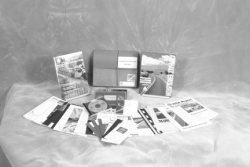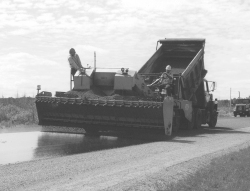Construction and Maintenance Fact Sheets
Pavement Preservation: Toolbox Resources
October 2001 FHWA-IF-02-010
PDF Version (700 kb)
Everything you ever wanted to know about pavement preservation...right at your fingertips. The new "Pavement Preservation Toolbox," assembled by the Federal Highway Administration and Foundation for Pavement Preservation, contains videos, CD-ROMs, reports, brochures, and other materials that provide a wealth of information on the state of the practice in pavement preservation. From explaining the preventive maintenance concept to selecting roads for preservation to choosing the right treatments, the Toolbox can help you get a pavement preservation program underway.
 As the Toolbox materials explain, pavement preservation involves the timely application of carefully selected surface treatments to maintain or extend a pavement's service life. An effective pavement preservation program includes the use of a range of preventive maintenance techniques and strategies, such as fog seals, slurry seals, thin lift overlays, crack sealing, and surface recycling for flexible pavements. Similar treatments for concrete roadways include crack and joint sealing, retrofit dowel bars, partial depth repairs, and diamond grinding. These treatments can reduce the amount of water infiltrating the pavement structure, slow the rate of deterioration, or correct surface deficiencies such as roughness. The key is to apply the treatments when the pavement is still in good condition, with no structural damage. It is estimated that the use of preservation treatments can extend the life of a structurally sound pavement by 5 to 10 years. As the Toolbox materials explain, pavement preservation involves the timely application of carefully selected surface treatments to maintain or extend a pavement's service life. An effective pavement preservation program includes the use of a range of preventive maintenance techniques and strategies, such as fog seals, slurry seals, thin lift overlays, crack sealing, and surface recycling for flexible pavements. Similar treatments for concrete roadways include crack and joint sealing, retrofit dowel bars, partial depth repairs, and diamond grinding. These treatments can reduce the amount of water infiltrating the pavement structure, slow the rate of deterioration, or correct surface deficiencies such as roughness. The key is to apply the treatments when the pavement is still in good condition, with no structural damage. It is estimated that the use of preservation treatments can extend the life of a structurally sound pavement by 5 to 10 years.
 Highway agencies that have made a Statewide commitment to pavement preservation include those of Ohio, Michigan, and California. Ohio recently issued new Pavement Preventive Maintenance Guidelines and has provided training on the guidelines to each of its Districts and Counties. Ohio has found that the major benefits of preventive maintenance include increased customer satisfaction, improved pavement condition and ride quality, safer roads, and lower life-cycle costs. Michigan, meanwhile, has set specific goals aimed at "keeping good roads good" through the use of preventive maintenance. The Department of Transportation (DOT) has set a target of having 95 percent of its expressways and 85 percent of its non-expressways in fair to good condition by 2007. The agency estimates that it has saved more than $700 million since 1992 by implementing a preventive maintenance program. Preventive maintenance also continues to be a top priority in California. The California DOT has dedicated $250 million to fund a series of preventive maintenance strategies, nonconventional asphalt concrete treatments, and pavement warranties. The intent of the warranty is to guarantee the pavement's service life and prevent typical failures that may occur in the first year after construction. Highway agencies that have made a Statewide commitment to pavement preservation include those of Ohio, Michigan, and California. Ohio recently issued new Pavement Preventive Maintenance Guidelines and has provided training on the guidelines to each of its Districts and Counties. Ohio has found that the major benefits of preventive maintenance include increased customer satisfaction, improved pavement condition and ride quality, safer roads, and lower life-cycle costs. Michigan, meanwhile, has set specific goals aimed at "keeping good roads good" through the use of preventive maintenance. The Department of Transportation (DOT) has set a target of having 95 percent of its expressways and 85 percent of its non-expressways in fair to good condition by 2007. The agency estimates that it has saved more than $700 million since 1992 by implementing a preventive maintenance program. Preventive maintenance also continues to be a top priority in California. The California DOT has dedicated $250 million to fund a series of preventive maintenance strategies, nonconventional asphalt concrete treatments, and pavement warranties. The intent of the warranty is to guarantee the pavement's service life and prevent typical failures that may occur in the first year after construction.

The Items in the Toolbox Include:
- Pavement Preservation State of the Practice (CD-ROM)
- Protecting Our Pavements: PREVENTIVE MAINTENANCE (Video)
- Pavement Preventive Maintenance Guidelines (Report)
- Pavement Preservation Today (Newsletter)
- Recommended Performance Guidelines for Micro-Surfacing (Report)
- Selecting a Preventive Maintenance Treatment for Flexible Pavements (Report)
- A Basic Asphalt Emulsion Manual (CD-ROM)
- Pavement Preservation: The Preventive Maintenance Concept (CD-ROM)
- Asphalt Emulsion Surface Treatment Descriptions (Pamphlet)
- Micro-Surfacing, Quality Assurance and Use Guidelines for Micro-Surfacing (Report)
- Asset Management: Preserving a $1 Trillion Investment (Article in May 2000 Focus Newsletter)
To date, the Toolboxes have been distributed at several State pavement preservation seminars. Copies will also be available at the National Pavement Preservation Forum II conference, scheduled for November 6-8, 2001, in San Diego, California. For information on obtaining copies, contact:
Bill Ballou, Koch Materials Company
Phone: 785-823-7645
Fax: 785-823-7024
Email: bill592@cox.net
To learn more about pavement preservation, contact your local FHWA division office or Steve Mueller*, System Preservation Engineer, at telephone: 202-366-1557; fax: 202-366-9981; email: steve.mueller@fhwa.dot.gov.
*April 2005 Update: The contact at FHWA's Office of Asset Management is Tom Deddens, 202-366-1557, email: tom.deddens@fhwa.dot.gov.
|